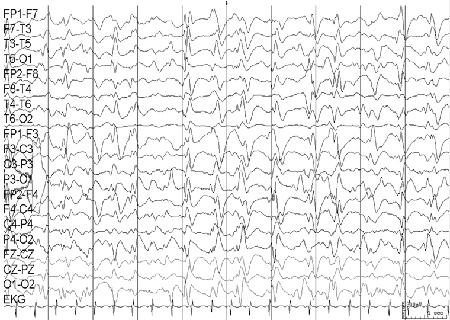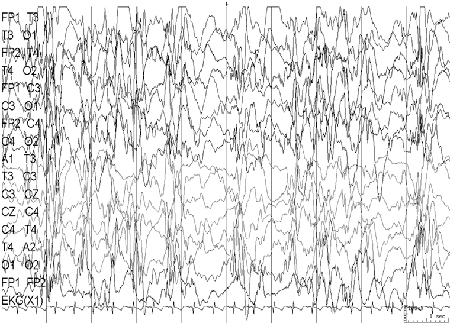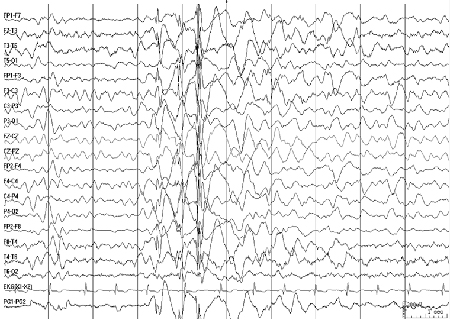Tests
1st tests to order
electroencephalogram (EEG)
Test
Standard diagnostic test.[23]
Epileptic discharges may be seen on the interictal recording. Abnormal rhythms are usually characteristic for specific types of epilepsy syndrome. [Figure caption and citation for the preceding image starts]: Electroencephalogram (EEG): epilepsy with myoclonic-atonic seizuresCourtesy of Professor Eric Kossoff; used with permission [Citation ends]. [Figure caption and citation for the preceding image starts]: Electroencephalogram (EEG): Lennox-Gastaut syndromeCourtesy of Professor Eric Kossoff; used with permission [Citation ends].
[Figure caption and citation for the preceding image starts]: Electroencephalogram (EEG): Lennox-Gastaut syndromeCourtesy of Professor Eric Kossoff; used with permission [Citation ends]. [Figure caption and citation for the preceding image starts]: Electroencephalogram (EEG): childhood absence epilepsy; shows typical 3 per second spike-and-wave patternCourtesy of Professor Eric Kossoff; used with permission [Citation ends].
[Figure caption and citation for the preceding image starts]: Electroencephalogram (EEG): childhood absence epilepsy; shows typical 3 per second spike-and-wave patternCourtesy of Professor Eric Kossoff; used with permission [Citation ends]. [Figure caption and citation for the preceding image starts]: Electroencephalogram (EEG): juvenile myoclonic epilepsyCourtesy of Professor Eric Kossoff; used with permission [Citation ends].
[Figure caption and citation for the preceding image starts]: Electroencephalogram (EEG): juvenile myoclonic epilepsyCourtesy of Professor Eric Kossoff; used with permission [Citation ends].
Up to 40% of children with epilepsy have normal interictal EEGs; therefore a normal interictal EEG does not exclude a diagnosis of epilepsy.
Hyperventilation, photic stimulation, and sleep deprivation may be used to provoke seizures.
A video EEG may be used to determine whether the clinically observed seizures are epileptiform in nature.
Result
abnormal rhythms specific to epilepsy syndrome; details for each syndrome are described in Diagnostic approach
blood glucose level
Test
Blood glucose measurement is an obligatory part of evaluation for any child with decreased consciousness level.
Should be ordered at least once for all patients with recurrent seizures.
Result
decreased in the presence of hypoglycemia
basic metabolic panel
Test
Ordered to exclude metabolic disorders or electrolyte imbalances if a secondary cause is suspected.
Should be ordered at least once for all patients with recurrent seizures.
Result
abnormal in the presence of metabolic or electrolyte abnormalities
CBC
Test
Ordered to exclude infection if a secondary cause is suspected.
Should be ordered at least once for all patients with recurrent seizures.
Result
normal or elevated WBC count
Tests to consider
MRI brain
Test
EEG and clinical picture is usually diagnostic; however, in cases where diagnosis is in doubt or a secondary cause is suspected, MRI is the definitive imaging technique in children, as it does not involve ionizing radiation and the images give more detail than CT scans.[29]
Result
no underlying pathology in idiopathic generalized seizures; may reveal cause in patients with symptomatic epilepsy
CT brain
Test
CT has a role in acute investigation for children with a recent history of a seizure and in whom an intracerebral bleed needs to be ruled out. It is also used when there are concerns about a space-occupying lesion and an MRI is not available.[29]
CT should not be utilized in a patient with an unprovoked, generalized seizure that has returned to baseline mental status.[7][23][30]
Result
no underlying pathology in idiopathic generalized seizures; may reveal cause in patients with symptomatic epilepsy
genetic testing
Test
Genetic testing is recommended for children with suspected Dravet syndrome. It should also be considered for suspected developmental and epileptic encephalopathies (including suspected early infantile developmental and epileptic encephalopathy, Lennox-Gastaut syndrome, and infantile epileptic spasm syndrome), or if structural abnormalities suggest a genetic cause.[21][32][33][34]
Result
mutations specific to epilepsy syndrome identified
Use of this content is subject to our disclaimer